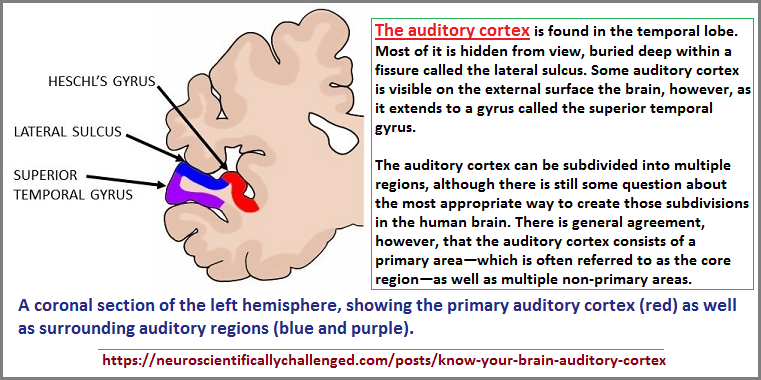Preface 1
Progressive Thinkers as of 12/1/2022
|
| ||||||||||||||||||||||||||||||||||||||||||||||||||||||||||||||||||||||||||||||||||||||||||||||||||||||||||||||||||||||||||||||||||||||||||||||||||||||
A Narrative on Language has three options. To be specific, to be general, or to be both. I will pursue all three perspectives in the forthcoming pages. To me, I compare the present population of 8 billion people with the number of languages and find that there are only a few hundred languages, some of which are falling by the wayside. In fact, it is not a certainty whether any major language living today will exist in a few centuries. The fitness of a language appears to parallel the fitness of biology. Though life continues, it may take on a form quite different from a predecessor, though some basic function and form may nonetheless be discernible on some level of examination, be it through the tools of physics, chemistry, genetics general biology, architectural (comparative) anatomy, or whatever discipline of inquiry one prefers. And even though a race of people may endure for awhile, their civilizations do not tend to have as a robust an internalized formative constitution with a celebratory level of integrity that we have thus found in the recurrence of a triplet code in DNA. Indeed, because DNA is part of what is preferred by many to be viewed as an expression of Evolutionary theory, one must wonder why it has not developmentally moved beyond a "three" code into a 4, 5 or more code, as would constitute a numerical representation of advanced complexity along a serialized avenue of presumed progress.
Whereas we can see a serialized advancement exposed in the Three (Triploblastic) Germ layers, with more complex forms of life exhibiting three layers and less complex forms of life exhibiting Two (Diploblastic) Germ layers, and the presumed existence of what may be called a One ("Monoploblastic") Germ layer that some describe as being exhibited by the simple animal life form called a Sponge; here too we do not see an evolutionary trek into a 4, 5 or more Germ layer construction, unless one wants to argue that biology is much too young in its Evolution for such structures to occur. The same goes for the development of Language. One must wonder whether human speech or the physiological means of creating speech is yet too young in its short history, whereby thousands of years from now all present day languages will be dead ones. One can only speculate.
As humans research in their respective areas of interest, they seek out some type of model which will assist them in taking their field into a next generation of development. Some use Mathematical models, some use atomic particle models, and others use biological models; though no field of study is to be considered unworthy of providing some semblance of a model which may at some time be useful for someone in what may be a totally unrelated field... or at least we think it is unrelated from our present cognitive vantage points. It stands to reason that a person with a different upbringing and different experiences brings to a given field of interest those internalized patterns which can be usefully applied and be the wonder of colleagues how their ideas were generated. However, because more and more youth are being subjected to a single-education framework of exposure within whichever culture they identify with, there is need for experiences of ideas to be found in areas of research (for pleasure or profit) beyond the normalized introductions more and more youth are sharing similarly in. In other words, it has become a growing standard for researchers to look in multiple fields in order to extract basic patterns which they can then approach with a tool of comparison and decipherment as if they were a comparative biologist, anatomist, chemist, mathematician, architect, etc... It is clear that one's field of interest requires at least some knowledge of basic structures (patterns) in multiple disciplines.
Let us take for example the field of Computer science in which its model of language is being formatted due to the underlying limitations of a dichotomously arranged on/off electrical switch. Whereas the evolution in computers has been to increase speed and increase memory and attempting to deal with the associated problems of increasing heat from such processes of acceleration, it is obvious to anyone who has ever been involved with building an automotive engine that increasing the power output of an engine increases heat, whereby most of the energy being produced is lost in heat dissipation, though some have tried to utilize the flow of hot exhaust gases with the development of a turbo-charging system. Nonetheless, the heat problem remains and all the automotive engineers know that regardless of changes in the engine design, fuel used, and cooling system, only so much of the heat can be dissipated. All too often it is the "loud speech" of an uncapped header system which excites a shade-tree hotrod enthusiast, whereas corporate automotive (engineering) enthusiasts must tone down the "language" of the system because it is against the law for the public to have rude (loud and boisterous) expressions being made by everyone. Noise pollution is a very real troublesome result of Industrialization.
Automotive engineers just like electronic engineers want to make quiet, efficient, safe, and affordable products. Both of them turn to creating languages which might assist in achieving this. All vehicles today come with small computers that exchange what may be called "conversations" between itself and the engine, including the environmental conditions and fuel, as well as what could be described as driver eccentricities. The operative word here is "Language", and all is needed for the present summary.
There are two language theories (meaning the presence of a dichotomy), which are standing out in front of all other ideas. One of them which we may call the "innate" contestant is being advanced by Noam Chomsky. On the other side of the boxing ring we have the "out-ate" contestant advanced by Steven Pinker. In short, what is being described with other labels is the (dichotomous) argument featuring the contestants Nature and Nurture, sometimes referred to as the Nature/Nurture controversy. An excerpt from the Britannica is useful in the present regard:
Whether instinct is construed as an urge or drive or as a way of behaving, genetic inheritance is usually either explicitly asserted or implicitly assumed. Indeed, there are contexts in which a claim of genetic a priori (being independent of experience) is virtually the sole point of appeal to instinct.
Language serves as a useful example. In the 1950s American linguist Noam Chomsky forcefully argued that, although children pick up the language and dialect they hear spoken around them, they must do so on the basis of prior grammatical knowledge, constituting a "language acquisition device" that they are presumably born with. This, according to Chomsky, is implied by the existence of universal constraints on syntactic structure, in which "the poverty of the stimulus" acts as a means of accounting for the spectacular blossoming of vocabulary and syntactic command around age 2 and for the restriction of language acquisition to a "sensitive period" ending before age 10. Belief in a preformed grammatical device, for which heard speech provides input for the generation of linguistic competence and performance, has spread among linguists. For example, Canadian American psychologist Steven Pinker, in his The Language Instinct (1994), gave the theory an evolutionary interpretation.
However, the language instinct theory remains controversial. Among those who oppose the theory are researchers who used computer modeling to determine whether a "neural" network could simulate the course of language development of a human child. They claimed that all the features that the language instinct was invoked to explain can arise in a "neural network" in the absence of any pre-designed structure of rules or grammar. The constraints on syntax and timing are emergent from self-organization within the network as it progressively adjusts connection strengths with repeated passage from input to output with reentrant feedback. However, the computer studies leave the issues of linguistic development unsettled. Thus, language instinct, similar to all other forms of instinct, can be described variously as encompassing genetically inherited, unlearned, reflex-like properties, driven from within, or as involving notions of impulsion, knowledge, and understanding.
Pinker's book on the language instinct and his later book, How the Mind Works (1997), belong to a field known as evolutionary psychology. This is a movement that views the human mind as designed by natural selection. As a result, it opposes the standard social science model, according to which the mind is a general-purpose cognitive device shaped virtually in its entirety by cultural influence. In contrast, evolutionary psychology argues that the mind consists of a number of functionally specialized modules. This organization acknowledges the existence of selection pressures that acted on human Paleolithic ancestors living in small hunter-gatherer societies. Although the term instinct is lightly used in the writings of evolutionary psychologists, it is pervasively implicit in the sense of inborn propensity or innate structure. ("instinct." Encyclopædia Britannica.)
What is being discussed, by way of a philosophical debate, are Three topics: Language, Computer Language, Cognition. Unfortunately, what is being overlooked is the usage of the two terms "Language" and "Cognition" to produce the idea of "Cognitive Language"; and the usage of three terms "Language, Computer, Cognition" to produce the idea of "Cognitive Computer Language"... though some readers may prefer to switch the words around to create some other amalgamated idea involving the three. One of the points to be made is that we don't commonly think in terms of human cognitive activity as a language. Whereas some may speak about a "Language of Ideas" which can refer to some idea assembled from pieces culled from different topics; a "Cognitive Computer Language" speaks of an ability to identify basic patterns, typically by using enumeration. While many speak of the duality of zeros and ones, they don't compare this presence with the same pattern being exhibited in different subjects, much less its frequency. Whereas many are familiar with the dichotomy being present in the old Chinese idea of the Yin/Yang, the idea is dismissed instead of being collated as a represented "two" pattern of cognitive behavior. In short, the human mind is speaking in a basic language with patterns that we can enumerate. There are different number patterns but there are only a handful of those which are re-occurring in all subject areas. (The absence of such patterns is also of interest to me.)
Human language is a very elaborate means of expressing basic cognitive patterns. Computer languages are being made more elaborate by complexity, and yet those seeking a new and better language resort to examining basic patterns such as electrical firings in neurons and between synaptic junctions which appear to mimic the dichotomous pattern of on/off electrical switching. Though I have yet to see anyone make mention of the mouth/anus development of organisms and how the arrangements have changed the further one proceeds up the evolutionary ladder. Nor have I seen anyone outside biology making mention of the "RNA" world exhibiting a "1" stranded value that is later accompanied by a "2" (double) stranded developmental value in DNA, yet there is no routinely expressed "3" value... though perhaps this will come in the future. Nor is anyone talking about the basic cognitive theme of "2" in the Yin/Yank profile being cognitively followed by an attempted "3" value by way of the I-Ching with its (false) triads. Similarly, we see the "2" (0s and 1s) of computer language being subjected to a "3" plan by the adoption of a Boolean (And, Or, Not) gate system. Also, in language we speak of the "2" Consonants/Vowels as a basic formula, which later becomes subjected to three-patterned structures, but every single Lindquist I come across is faithfully ignoring the importance of hearing to language. If you look at the recurring dominant pattern in the structure of the ear, it should hit you over the head that such a pattern has an influence on Language:
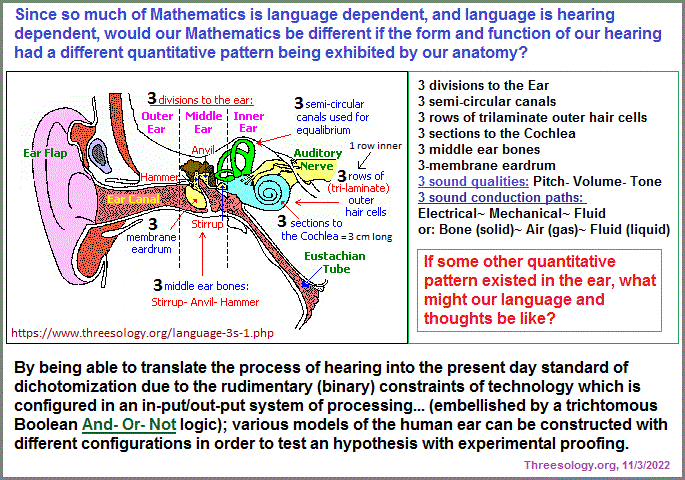
Such a presence of a recurring pattern as the "3" in an actual physical implantation, affords us to take the study of language, and hence, computer language and cognition to the next stage of discussion, by subjecting the design of the human ear to constructions of the ear with alternative patterning and noting how the input versus output changes. If you change the design of a person's anus-system, what goes in may well be altered as to how it comes out. If humans had their anus at the back of their head, the entire civilization of humanity would have to adapt accordingly. Likewise, even without changing what languages are presently being used by humans and computers, if we alter how they come out, the Industrial and social system will have to change in accordance therewith. Likewise, if we view this in reverse: altering the social environment can impact the language being used. For example, the language used by Concentration camp inhabitants differs remarkably from that under more normalized cases. In several cases, language become mute. Jargonized sign languages become used in camouflaged ways. Likewise, the human and computer languages presently be used are camouflaged (embellished) expedients which cause their underlying patterns to be overlooked because the cognitive language that has been adopted necessarily engages in "camouflaged (embellished) expedients". Such a situation is not difficult to see nor understand by looking at the language adapted to and adopted by those who resort much of their day to text-messaging. The same thing occurred to those who were once engaged in the telegraph (language) system or those who adopted some other lingua franca which made it more difficult for anyone to see past the basic expressions to underlying basic patterns of speech and cognition, though the arena (a marketplace for example), was small. Much like one having to learn the type of communication among flea market vendors as opposed to more common speech not involved with merchandise and selling.
If we view all languages as argots, or slang, or specialized vernaculars, or jargon, etc., and include computer languages as well as the virtually unrecognized cognitive language(s), then searching for a universal language which can assist in propelling humanity towards a next step in evolution by way of a language vehicle, can be better understood. Getting people to work towards a similar goal is much easier if they know what you are attempting to accomplish. Whereas we have several people on the same page, except that for some the page is upside down, for others they are covering up most of it to read it line by line without seeing any larger picture of the context or content, and still others have managed to incessantly scribble, underline, stain, color, etc., this or that portion, including the placement of what they think are important marks and messages along the margins.
Many people overlook that the long-enduring usage of a bipedal gait can and has affected human thought... and not doubt language. Likewise, they overlook that many of them learned to ride on a (two-wheeled) bicycle, and not a uni-cycle. While, depending on one's era, one's country, and socio-economic status of one's childhood they may or may not have started out on a four-wheeled or four-legged creature, though some may have been introduced to a 3-wheeler. The point is that the use of basic patterns is all around us and affecting us as we effect their existence to correspond to the basic language of our thinking. But there is a communication error taking place between assumed professionals, much less the lay public. For example, a reference to an actual event may be insightful for some readers:
An appointment for a friend of mind through the audiology department of a VA (Veterans Administration) Hospital in Salt Lake City resulted in him having three appointments on the same day, but out of order. He was supposed to have his hearing checked before seeing an audiologist specialist but that the two offices did not confer with one another well enough to ensure that the correct order of appointments took place. Besides this, he was scheduled to have an at-home appointment over the computer (due to Covid-19), despite the fact that he couldn't hear and there was no one around to assist him! Only by physically showing up at the hospital to both separate departments for the appoints which were (unbelievably) in separate buildings, were he and I able to get the irrationality straightened out. However, he still took them out-of-order and decided not to go back to the audiologist because he had a miserable bedside manner, and (I say stupidly) wanted my friend to answer his questions even though my friend could not hear him and he did not want me to s peak for him... even on general questions. And no, I don't think he was using the questions as a means of judging how well my friend could hear or not. He just wanted to be in control, to be the "authority" figure. It was a worthless visit because all he prescribed was the anti-inflammatory drug Prednisone and didn't even check the condition of the ears past a routine exam that any child with an Operation! game could have done, even though a microscope for the ears was available. He remarked that Prednisone was "all we have" in dealing with hearing problems.
The point of the story is that these two departments with "professionals" (focused on an interest in hearing no less), did not listen nor adequately communicate not only between themselves, but with my friend whose wife was even confused by the mixed messages being received. And by the way, my friend tried a hearing clinic in the private sector only to find that after the third visit (each with a 50 dollar co-pay), this is when his ears were finally checked with a microscope. And again, Prednisone was prescribed but turned out to make him sick. The private sector hearing clinic was pedaling the purchase of hearing aids... at an exorbitant cost. (Whatever happened to the virtues once espoused by the Hippocratic oath?)
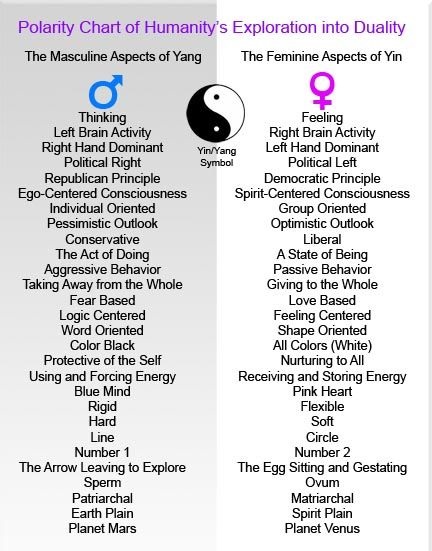
What I am saying is that with so many people studying a language problem from a selective vantage point is that we have a selective listening problem. And though instructors are trying to devise a uniform model of teaching the same issues being confronted in our attempt to grasp the scope (larger picture) of the problem, the basic patterns (which can be enumerated) are not being recognized across multiple subject areas as an expressed cognitive language. It's incredible to think that we humans have not come up with the idea that the cognitive processes of humanity did not exercise some early attempt at expression within the limitations the brain was exposed to, such as the skull and the rhythmic patterns it was subjected to. For example, the two-patterned gait, two patterned arm swing, the two-patterned (lup-dup) heart rhythm, and the exposure to an environment in which extremes create the eventual consciousness of multiple dualities clearly shown in a yin/yang compilation of duality examples, and are a means of reference the cognitive subject of a "1" and later "3-pattern" orientations (and supposed furtherances) that might alternatively be described with terms such as tertiary, plurality, Many, heap, multiplicity, infinity, etc...
The pumping of the heart, or the heartbeat, is caused by alternating contractions and relaxations of the myocardium. These contractions are stimulated by electrical impulses from a natural pacemaker, the sinoatrial, or S-A, node located in the muscle of the right atrium. An impulse from the S-A node causes the two atria to contract, forcing blood into the ventricles. Contraction of the ventricles is controlled by impulses from the atrioventricular, or A-V, node located at the junction of the two atria. Following contraction, the ventricles relax, and pressure within them falls. Blood again flows into the atria, and an impulse from the S-A starts the cycle over again. This process is called the cardiac cycle. ("heart." Encyclopædia Britannica.)
And yet, despite the influential presence of a "two pattern" having some bearing on being able to influence the contour of human thinking, we find that the value of three plays a major role, as is exemplified in List of Threes in human anatomy. As if Nature likes to use a tripod in several circumstances such as in particle physics expressed easily by denoting Protons- Neutrons- Electrons.
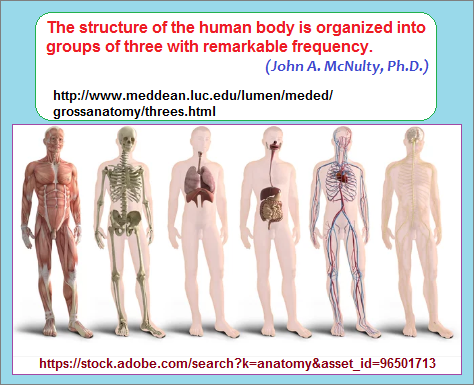

Let's take a different approach at what I am describing. Whereas a person comes across the language of mythology, or legends or Fairy tales, they become so enamored at identifying person-related themes they can not, do not, or refuse to look for basic patterns of language beneath all the labels typically used by language in how its views are being organized. Whereas you see the two-patterned Consonant/Vowel arrangement that another adds a third called Suprasegmentals, the "2" and "3" are not seen as a cognitive language expression. However, one should not think they alone are overlooking this simple pattern, because many cognitive scientists are doing likewise. They have not even considered that human cognition has a language. They think language is reserved only for vocal utterances, even though cognitive activity came onto the seen of development long before vocal speech, unless one wants to include infant babbling... a topic that I will get into on a later page.
The aforementioned two-beat of the heart needs to be looked at from a perspective that steps back and takes stock of a rather curious feature that we can see in the lungs as well:
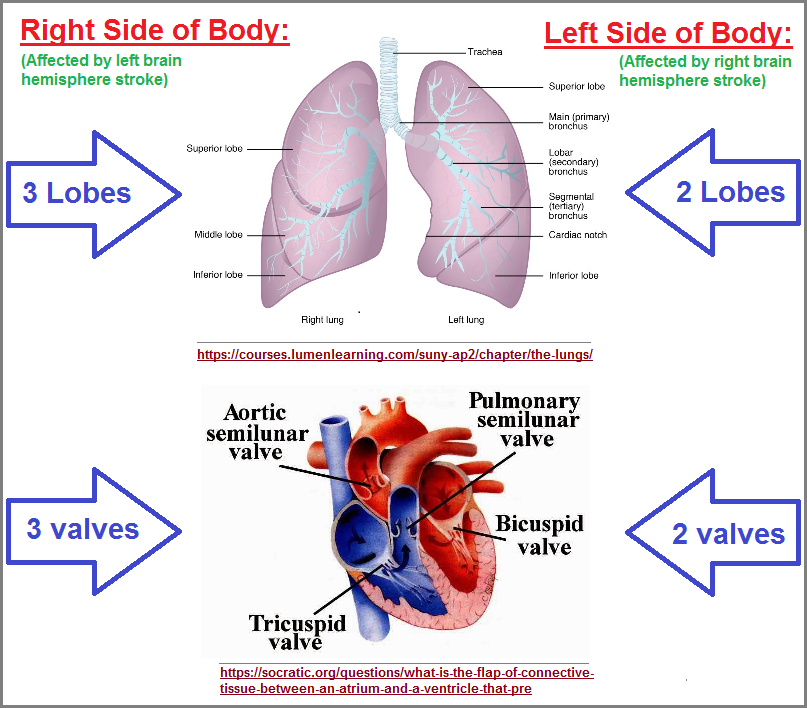
The above image gets a bit more interesting and perhaps a bit more controversial when we step even further back and take stock of the cognitive attributes one might assign to the brain hemispheres, keeping in mind that the reptilian brain (from a triune brain perspective) is not being mentioned and that it should be emphasized that during a (cerebral) stroke, if it occurs on the left hemisphere being designated with the value of "3", the right body side with the designated "3" patterns of the lungs and heart are correspondingly on the opposite side and vice versa with respect to a stroke occurring in the right hemisphere. It doesn't matter whether you accept the idea of hemispheric attributes as they are listed here, or that you prefer more of a spread-out overlapping sort of composite; the fact remains it is an interesting correlation, particularly when we are dealing with a proposed 2 and 3 variation in cognitively organized ideas display a 2 and/or 3-patterned architecture... and whether or not you have considered the idea of a 1-2-3... developmental sequence.
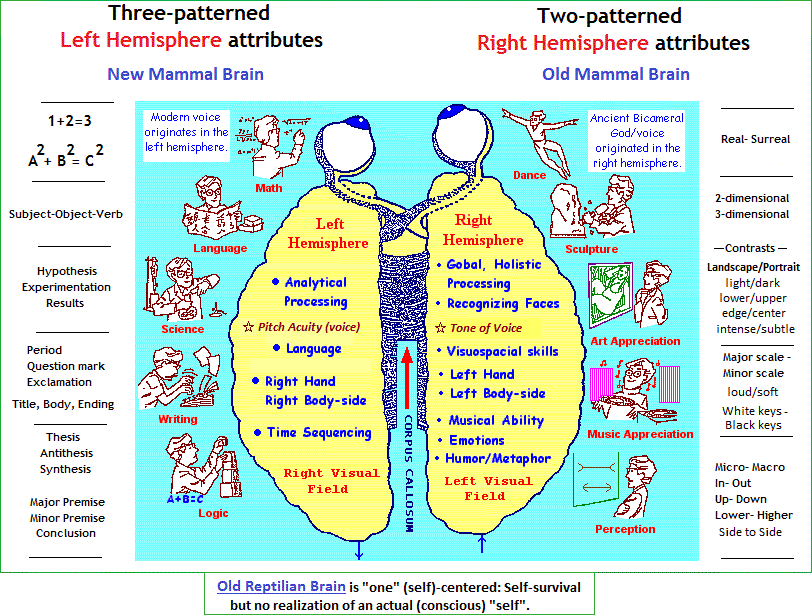
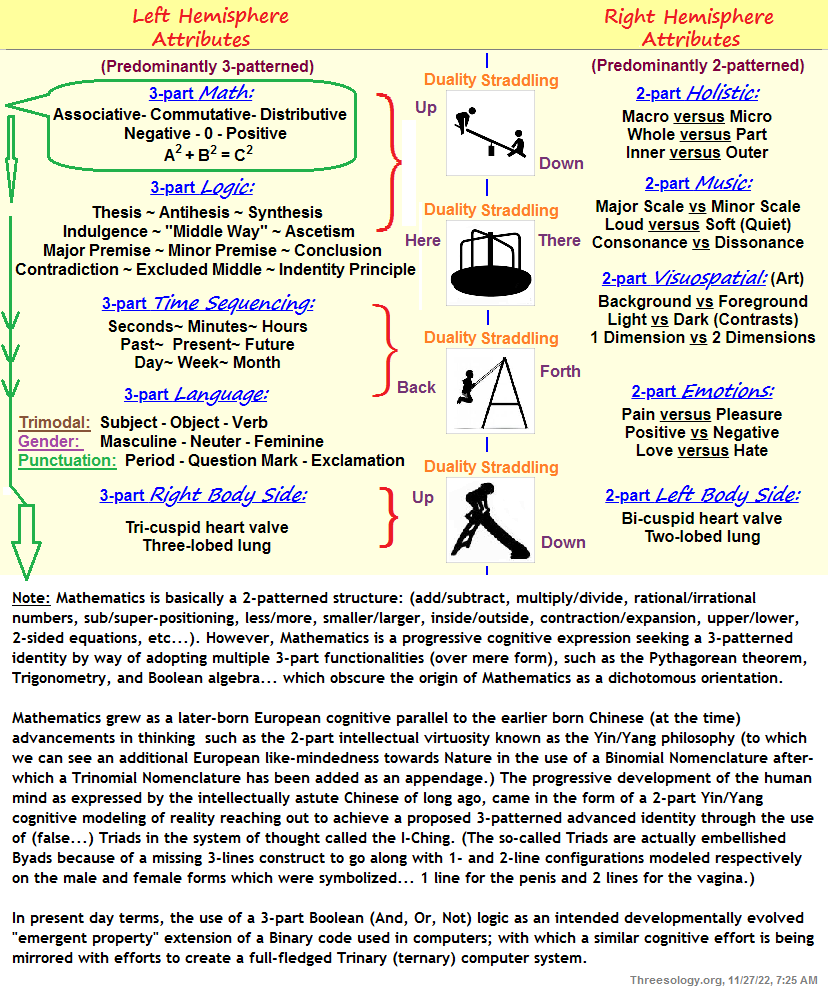
In the above brain image I denote the attribute "Pitch Acuity (voice)" for the left hemisphere and "Tone of Voice" for the right hemisphere. While some references will say that tone and pitch are "heard" equally by the brain, the following reference describes the idea of acuity to the right side of the brain. Since I will be mentioning tone and pitch later on, it is an important distinction to be made with regards to hemispheric lateralization and basic enumerations which can be used to provide an initial probe into the area of a cognitive language which might well have emerged long before the type of language we identify with vocal expressions. For example, did primitives vocalize some spoken language equivalent to notches on a bone (stone, shell, etc...) which represent the numbers and quantities we of today reference as 1, 2, ...? Indeed, did primitives count higher than one, or two, or three, and merely mimicked a one or two and we of today misinterpret multiple etchings as indicative of a large system of enumeration?/p>
Numerous studies have identified the lateral Heschl’s gyrus (HG), located adjacent to the anterolateral border of primary auditory cortex along the superior temporal gyrus, as the putative "pitch center". Heschl’s gyrus is one of the first and most consistently identified areas to be activated by pitch modulation. The temporal and spectral maps are distinct within the primary auditory cortex but appear to overlap portions of HG. Many of the studies implicating the lateral HG also showed activation of the planum temporale (PT), located more posteriorly along the superior temporal gyrus, as previously reviewed. Taken together these studies call into question the idea of a singular specialized region for pitch. A recent meta-analysis of fMRI studies showed loci for pitch processing in the superior temporal gyrus lateral to Heschl’s gyrus. They also found that processing of infrequent pitch changes was centered in PT, significantly posterior to other areas of pitch processing. In some listeners, pitch responses were also identified in the temporo-parieto-occipital junction or the prefrontal cortex, suggesting that significant individual variation may exist in the localization of pitch processing.
Initial stages of pitch processing occur symmetrically between both cerebral hemispheres. Asymmetries begin to emerge when temporal information is taken into account, i.e. melodies versus fixed pitch. In the right-lateralized areas of Heschl’s gyrus and the antero-lateral border of the planum temporale (PT), there were markedly increased responses to modulation of complex tones. When pitch stimuli create melodies, even further cortical areas from Heschl’s gyrus and the planum temporale are activated, consistent with further processing of melodic sound in an anterolateral direction. Thus, in the hierarchical structure of pitch processing in the auditory cortex, pitch is initially extracted bilaterally, whereas long-term variations in pitch are subsequently processed further (Figure 1). One plausible interpretation is that the left hemisphere has selective acuity at encoding temporal changes, whereas the right hemisphere possesses superior spectral resolution, which is necessary for detecting changes in both pitch and timbre. (Neural Mechanisms Underlying Musical Pitch Perception and Clinical Applications including Developmental Dyselxia, by Christopher J. Yuskaitis, MD PhD, Mahsa Parviz, BS, Psyche Loui, PhD, Catherine Y. Wan, PhD, and Phillip L. Pearl, MD)
Structure of the Primary Auditory Cortex:
The primary auditory areas are regions of the cerebral cortex located bilaterally in the temporal lobes. The primary auditory area is housed within Heschl gyrus, a region that is positioned posteriorly in the superior temporal lobe within the supratemporal plane. This cortex, along with associated auditory areas, is clustered surrounding the posterior aspect of the Sylvian fissure or lateral sulcus of the cerebral cortex, which separates the temporal lobe inferiorly from the parietal and frontal lobe superiorly. Heschl gyrus cannot be visualized from a lateral view of the cerebral cortex since it is located deep to the superficial temporal lobe structure and is within the lateral sulcus. It runs towards the center of the brain in a medial-posterior fashion. The left Heschl gyrus in the majority of individuals is significantly longer when compared to the right gyrus, suggesting a correlation between left-hemisphere language dominance and associated differences in anatomical structure. (Neuroanatomy, Cortical Primary Auditory Area by Sarah A. Mangold & Joe M Das., Last Update: July 25, 2022.)
Let it be noted that developmentally speaking, the right brain hemisphere sits a bit forward of the left side and starts its development earlier. When we associate a perceptions of tone with the right hemisphere and then view this in context with tonal languages, this suggests that this type of language phenomena may have preceded the emergence of non-tonal languages. If in being first to develop as an expression of an evolutionary lineage linked to age, and that humanity as we presently know the species has a shelf-life, the deterioration of the right hemisphere and its associated attributes (such as tonal languages) may be the first to exhibit such a characteristic as humanity goes further into the future. While I can conjecture as to the possibility of a third type of language superseding non-tonal languages may arise (or is present and trying to emerge but current systems of society are getting in the way and creating numerous obstacles); I do not as yet have any definitive representation thereof.
The right brain hemisphere is dominant in human infants, by C Chiron, I Jambaque, R Nabbout, R Lounes, A Syrota, O Dulac
The development of functional brain asymmetry during childhood is confirmed by changes in cerebral blood flow measured at rest using dynamic single photon emission computed tomography. Between 1 and 3 years of age, the blood flow shows a right hemispheric predominance, mainly due to the activity in the posterior associative area. Asymmetry shifts to the left after 3 years. The subsequent time course of changes appear to follow the emergence of functions localized initially on the right, but later on the left hemisphere (i.e. visuospatial and later language abilities). These findings support the hypothesis that, in man, the right hemisphere develops its functions earlier than the left.
On the one hand we have computers with an underlying "2" (Binary) pattern expressed by the enumerations of zeros and ones, and that in an effort to exceed this "two" or double pattern a "3" patterned Boolean Algebra of "And- Or- Not" is applied; and yet on the other the fact that people are trying to develop a computer system with a 3 (ternary/trinary) language as an expressed evolutionary type of advancement, does not ring any bells of consciousness that we are dealing with a recurring cognitive language. Oh, and yes, some of you may exclaim that there are other patterns besides 2s and 3s, let me remind you that I did say there were other patterns but only a handful are being used routinely. There are numerical patterns outside the handful which are routine, but we must make note of them just as we make note of anomalies such as deformities or even the recurring residuals of development noted as vestigial organs. In other words, I am speaking about what I am (and will repeat myself) describing as the presence of what appears to be a "Conservation of Number" which we need to apply to our study of Language. For example, a medium we use for expressing language is the use of a pen or pencil, which are held by three fingers. We use three standard forms of sentence ending punctuation called the Period- Question Mark- Exclamation point. And let me make reference to the three-part Subject- Object- Verb method used in analyzing sentences called Word Order.
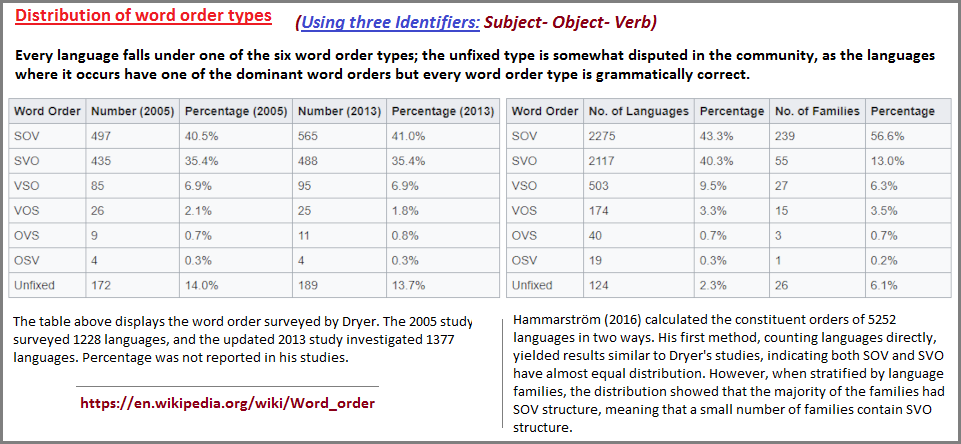
The Visual system of color occurs in what is described as a (limited) spectrum:
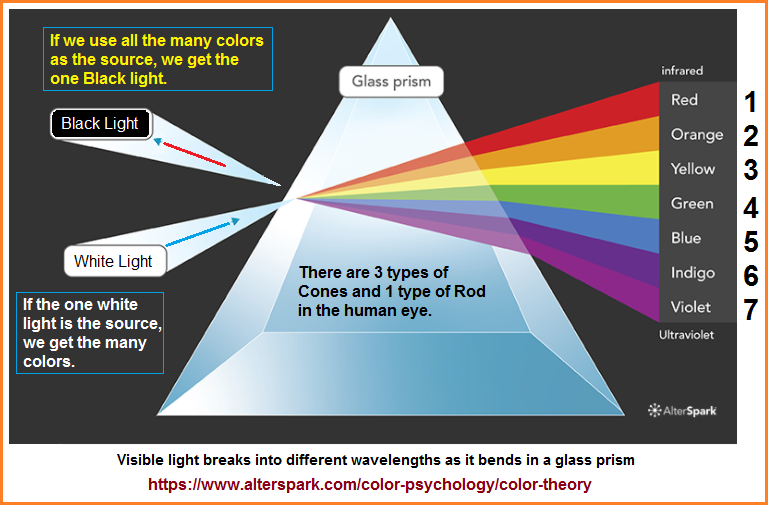
Likewise, if we look at vocal ranges or the range of music, we find limitations. Similarly, if you were to look, we find a limitation to imagination just as we find a limitation as to what the human body can do and not do, as represented by sports records, such as those compiled for the Olympics. (However, the ego of humans wants to deny there are limitations to intelligence, wisdom, imagination, inventiveness, creativity, etc... Indeed, it is frequent that many exceptional or above-average attributes of an individual might be described as a gift from god or heaven, whereby suggesting it is akin to some source of limitlessness.) Within the ranges are frequent and non-frequent occurrences. We can site, if we wanted to, the averages of low, medium, and high occurrences, along with variation in between. With respect to language, the English alphabet can be used as an example of a range from A to Z. Within this range we have some letters which appear to show up more frequently than other letters. For example, take the following illustration of letter frequencies for a given sampling:

This same idea can be used to display the cognitive language usage of enumeration. Some number patterns will show up more frequently than others, but I can not at present say whether there are 26 recurring numbers. The number patterns being used most often by the "cognitive language system" may be much smaller. The following is a hypothetical chart of numbers I through together showing more uses of the numbers 2, 3 and 7 than other numbers, but the actual system of "enumerated language expressions" of human cognition may be different:
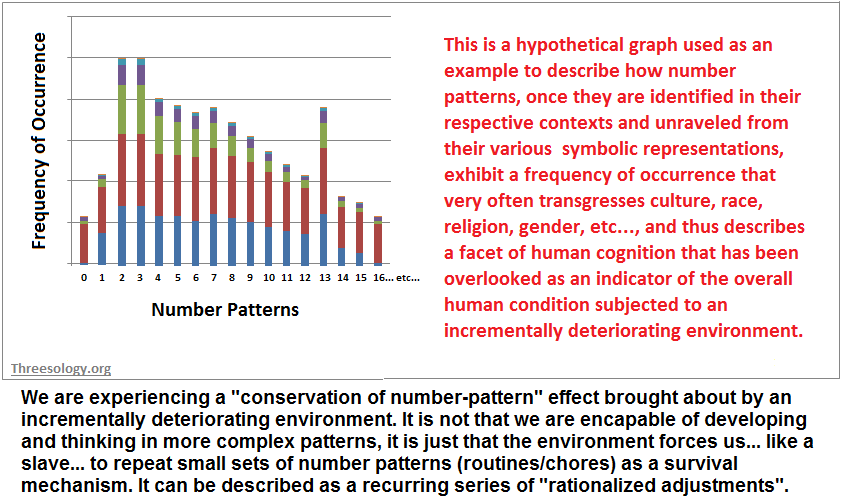
In presenting "A Language Narrative", I sometimes resort to a story-telling mode of expression. So if you are expecting a die-cut version of some academically required format exercised as a thesis as part of a requirement for an advanced degree, you will be disappointed. I take liberties in my writing wherever and whenever I want to, since I often work on different pages at different times with different thoughts in mind. However, this 1st preface should suffice as an illustration that I am engaged in a serious undertaking... but I have to have some fun along the way.
Origination of this Preface (1): Wednesday, 7th December 2022... approx. 4:00 AM
Date of Initial Posting (Preface 1): Wednesday, 7th December 2022... 12:20 PM (Arizona Standard Time); Marana, AZ.
Updated Posting: Thursday, 8th December 2022... 6:46 AM
